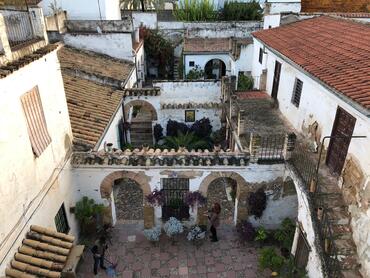From Prehistoric Paintings to Gaudí’s Pavilions: A History of Our Spanish Affiliate

From awe-inspiring cave paintings dating to the earliest days of humanity to the exuberant whimsy of Catalan modernism, the project sites of our Spanish affiliate office cover thousands of years of artistic creativity. Since opening in 1992, WMF Spain has undertaken a number of projects related to promoting balanced tourism, from inventive virtual-reality installations at vulnerable sites to addressing the challenges of depopulation by using tourism to stimulate economic opportunities. Learn more about the evolution of our work in Spain over time—and how our projects there have fostered sustainable visitation practices.

Paintings of animals on the wall of La Garma Cave, Spain.
La Garma

The forests of northern Spain conceal the entrance to La Garma, a multi-level cave system housing one of the most extraordinary collections of paleolithic rock art in Europe. A UNESCO World Heritage site, La Garma includes keenly observed renderings of ancient animals, handprints, and thousands of bone and shell fragments. Thanks to a landslide that sealed the cave thousands of years ago, this art has been preserved to a remarkable degree.
However, the extreme delicacy of La Garma’s artifacts and artwork of La Garma means that opening the site to visitors would lead to irreparable damage. In order to share the cave’s marvels with the world while physically protecting the site, WMF Spain collaborated with the Stuart Weitzman Foundation to produce a virtual reality tour of the cave. In January 2020, Forbes included Memoria: Stories of La Garma among the top virtual reality experiences of 2019.

Historic houses of Tebaida Leonesa, Spain. Santiago de Peñalba, Tebaida Leonesa, 2018

The quiet and tranquility of the rural area known as Tebaida Leonesa in León has earned it the nickname “the Valley of Silence.” Beginning in the seventh century, monks established religious communities in the area to take advantage of Tebaida’s peaceful setting for spiritual contemplation. Today, the valley is home to extraordinary medieval architecture and has preserved its legendary calm—but economic shifts and the migration of young people to the cities has put its communities under strain.
Beginning in 2018, WMF Spain began working to thread a difficult needle: developing a sustainable tourism strategy for the region that would boost the local economy without sacrificing Tebaida Leonesa’s authentic charm and serenity through restoring the original wall paintings at the Church of Santiago de Peñalba, as well as promoting visitation to this unique Monument.

Aerial view of the Courtyard Houses of Axerquía in Granada, Spain.

The UNESCO World Heritage site of historic Córdoba is internationally known for its courtyard houses. During the annual Fiesta de los Patios—itself recognized as Intangible Cultural Heritage of Humanity by UNESCO—the courtyards are decorated and open to the public, receiving thousands of visitors each year. But as long-term residents abandon their courtyard houses, the area has steadily depopulated, putting the homes and the traditions associated with them in jeopardy.
The Courtyard Houses of Axerquía were included on the 2020 World Monuments Watch to spotlight local efforts to repopulate the historic center and encourage further stakeholder and government engagement. By bringing awareness to local initiatives to restore abandoned houses and regenerate the area, WMF Spain called for improved and inclusive management to ensure a better quality of life for the residents in historic centers.

One of famed Catalan architect Antoni Gaudí’s earliest projects was Güell Pavilions and Garden, named for the man who would become his greatest patron: the textile magnate Eusebi Güell. A fantastical wrought-iron dragon, a reference to a famous Catalan poem, guards the entry gate to this complex, which comprises a stable, horse training ring, and gatehouse in west Barcelona. The site is also where Gaudí first experimented with trencadís, the mosaic technique that he would later use so exuberantly in many of his most famous buildings, including Park Güell and the Sagrada Família.
WMF placed the pavilions and garden on the 2014 World Monuments Watch to galvanize support for improved public access to this important part of Gaudí’s legacy. After Güell Park and Pavilions’ inclusion on the Watch, the University of Barcelona and the city reached an agreement on the site’s restoration. In late 2015, both the gardens and the stables were opened for tourism, education, and civic activities. WMF is continuing work on the restoration of the iconic gate thanks to the Manitou Foundation.
World Monuments Fund's work at the Caves of Cantabria, including La Garma, has been made possible, in part, by support from The Robert W. Wilson Charitable Trust, Stuart Weitzman, the Weitzman Family Foundation, and Barbara Kreger.
World Monuments Fund’s work at Tebaida Leonesa has been made possible, in part, by support from American Express.
World Monuments Fund’s work at the Courtyard Houses of Axerquía has been made possible, in part, by support from American Express.
World Monuments Fund’s work at Güell Pavilions and Garden has been made possible, in part, by support from American Express and from Nora McNeely Hurley and Manitou Fund.
